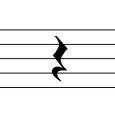How to Read Music - Rests
Despite how interesting it would sound, music does not consist of non-stop music notes. There need to be rests mixed into the song in order for the song to sound the way the composer intended it to sound. Every song needs rests, otherwise, like I mentioned before, it would sound like a bunch of notes going non-stop without any breaks. I think that might sound a little bit odd. This article will walk you through the basic rests in sheet music and help you get another tool under your belt for creating music.
Quarter Rests
As you may have guessed, these rests are close relatives of the quarter note. In 4/4 time, they occupy one quarter of the measure and last one beat....the same length as a quarter note, except not played out loud. If you are counting a measure and there are three quarter notes and one quarter rest at the end, you might could something like this: dah...dah...dah...(silence). If you were do the same thing except there was a quarter note, then a quarter rest, then a quarter note again, and finally a quarter rest, it would sound like this: dah...(silence)...dah...(silence). I hope that makes sense, rests are pretty easy to figure out because you do just what it tells you...rest for the set number of beats.
Eighth Rests
Eighth rests are the same length as eighth notes and take up the same one eighth of a measure as the eighth note. It would take eight of these rests to fill one measure with silence.
Sixteenth Rests
As the name implies, the sixteenth rest is of the same form as the sixteenth note, taking sixteen to fill a measure.
Half Rests
The half rest is the same length as a half note and it only takes two half rests to rest for one measure. The symbol for the half rest is a rectangle that sits atop the middle (halfway) of the staff. It can be easily be confused with the whole rest but you can usually tell the difference easily by looking at the rest of the measure and the time signature. If there are two quarter notes and a rectangle rest...chances are it's a half rest!
Whole Rests
Whole rests tell you to rest for an entire measure. This is composed of two half rests, which would be the same length as a whole note as the name suggests. Like I mentioned above, these can be easily confused with the half rest, but its important to remember that the staff line that the whole rest is attached to is not halfway down the staff, like the half rest is.
Longer rests can be written as a black bar with a number in the middle of it. These are called bar rests and this number tells you how many measures to rest for. This is useful for the cymbal player who only has one big CRASH at the end of the song...why write 164 whole rests when you could just write a 164 measure bar rest.




